|
June 29, 2006
Hello from Montreal - A Driving Tour as
a great Introduction to a Fascinating City
Shortly after my arrival in Montreal,
right around 1 pm, I met Carole, a licensed professional tour guide
from Guidatour
in the lobby of the Holiday Inn and she was going to be my local
expert on a driving tour through the centre of Montreal. I had only
been in Montreal once before 10 years ago, so I really needed a
quick overview of the city to familiarize myself with its layout.
And although Montreal's downtown area is very compact and walkable,
a driving tour would give me a great introduction to this metropolis.
From my hotel we drove south on St. Urbain Street and our first
big sight was one of Montreal’s key tourist destinations:
the Place d’Armes and the exquisite Basicilica of Notre Dame,
Montreal’s largest and most beautiful cathedral. From there
we passed by Montreal City Hall and then made our way up the Boulevard
St. Laurent, also referred to as “The Main”, for generations
the traditional path of successive waves of immigrants as they made
their way north the port area to settle permanently in other neighbhourhoods
of the city. We passed by the Hotel Godin, a former garment factory
that has recently been converted into a boutique hotel, one of many
revitalized historic buildings that has been turned into a modern
hotel.
Prince Arthur Street further north is a pedestrian street featuring
a variety of reasonably priced restaurants with outdoor patios.
This area was a hotbed of hippie culture in the 1960s and today
provides a great selection of family restaurants. A little further
west we decided to have lunch at Chez
Gautier, one of Montreal’s most well-known bistros, established
in 1978. Chez Gautier’s Parisian-style décor features
beautiful woodwork and a magnificent handcrafted glass dome ceiling
in the bar area.
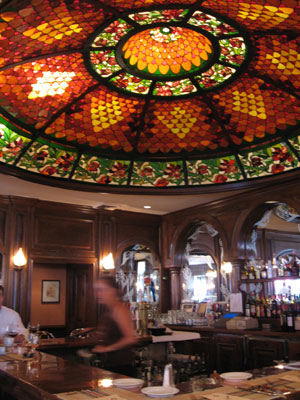
Glass dome at Chez Gautier
Right next to Chez Gautier and under the same ownership is la
Patisserie Belge, a pastry shop offering a wide selection of
beautifully designed cakes and baked goods. Carole and I sat down
on the beautiful terrace where I satisfied my cravings for an authentic
French onion soup as well as a salad with warm goat cheese and toast.
It was a delicious light lunch that reenergized me to continue with
my explorations.
Our driving tour continued with a trip further north, passing by
the Parc des Ameriques, a park that celebrates the city's Latin
American immigrants, until we reached the Mont Royal neighbourhood,
just to the east of famous Mont Royal. This whole area is referred
to as the “Plateau”, a reasonably flat area just east
of St-Denis that is subdivided into several smaller neighbourhoods.
This is one of Montreal’s trendiest neighbourhoods.
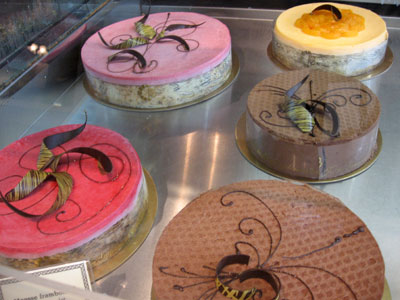
Cakes at la Patisserie Belge
West of the Plateau is Outremont neighbourhood which covers the
area adjacent to the mountain. The mix of ethnic groups was evidenced
by the coexistence side-by-side of a synagogue and a Chinese church.
Carole pointed out that some of the best bagels can be had on Fairmont
Street. Cote St. Catherine is the main boulevard of Outremont and
surrounded by a variety of parks and stately homes. Outremont is
one of the most desirable areas in Montreal and used to be a Francophone
stronghold, while Westmount, the neighbourhood on the southwest
slopes of Mont Royal, historically used to the bastion of English
speakers.
We passed by the University of Montreal, one of Montreal’s
four universities, two of which are geared to Anglophones and two
towards Francophones. The UOM is primarily French speaking and its
campus was designed by famous architect Ernest Cormier who was one
of the first to introduce Montreal to the Art Deco Style. We continued
on Cote des Neiges, a multi-ethnic neighbourhood of recent immigrants.
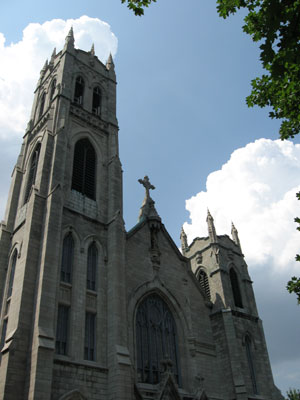
Historic church in the Plateau area
The big attraction on the northwest side of Mont Royal is Saint-Joseph’s
Oratory, topped by the second largest dome in the world after St.
Peter’s in Rome. The oratory was built as a result of the
efforts of Brother André (1845 to 1937), a man of very humble
beginnings, who used to be the doorkeeper at the Collège
Notre Dame across the street. Many miracles are attributed to Brother
André and he was beatified by Pope John Paul II in 1982.
In 1904 Brother André started construction on a small chapel
on the mountain side, facing the college. This chapel became too
small, so in 1917 a church with 1000 seats was built. In 1924 finally
the construction of the basilica started and was finally completed
more than 40 years later in 1967. St. Joseph’s Oratory is
a magnificent building and one of Montreal's major landmarks. Driving
into the city from the west you can see this glorious structure
for miles.
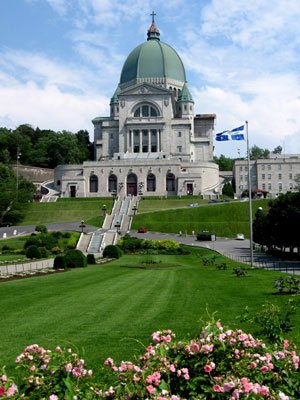
Right around the corner is the École Polytechnique where
a deranged Marc Lepine killed 14 women in December of 1989 in what
has become known the “Montreal massacre”. A permanent
memorial has been erected to commemorate this infamous incident
and to keep the memory of all female victims of violence alive.
The Notre-Dame-des-Neiges Cemetery, begun in 1855, is Montreal’s
largest cemetery and holds many of the city’s most prominent
citizens. More than 800,000 people are buried here and many exquisitely
carved gravestones bear testimony to many prominent residents. While
Notre-Dame-des-Neiges is the city’s largest French catholic
cemetery, the Mount Royal Protestant Cemetery right next to it is
the last resting place for many of Montreal’s most prominent
Anglo residents.
Mount Royal is Montreal’s highest point at 223 m and presents
a huge green space for the city dwellers. The park dates back to
1870 when local Westmount residents were concerned about deforestation
on the mountain due to the cutting down of firewood . Famous landscape
designer Frederick Law Olmstead, the creator of New York City’s
Central Park and many other American public green spaces, was commissioned
to design the Parc du Mont-Royal.
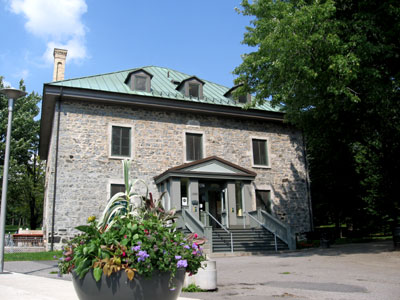
Maison Smith on Mont Royal
Our first stop in Parc Mont-Royal was at Castor Lake, an artificial
lake created in 1958 in what was formerly a swamp. The lake is surrounded
by meadows and trees and used as a skating rink in the winter. We
then parked our car just a bit further up the mountain, right next
to the Maison Smith, the last remaining former farm house on Mont
Royal which today offers various exhibits and activities. The basement
of this building houses a very large gabbro rock which is an example
of the igneous rock that makes up Mont Royal and several of the
mountains in the Monteregie region of Quebec. Contrary to popular
belief, Mont Royal is not an extinct volcano but the result of magma
intrusions.
After a brief hike through a forested pathway system we arrived
at Montreal’s famous lookout, the Belvédère
Kondiaronk (named after a Huron chief) overlooking the downtown
skyscrapers. Incidentally, Montreal's skyscrapers are not as high
as those in some other cities, since according to local stipulations,
none of the buildings is allowed to be higher than the mountain.
The view from this lookout is astounding and I wish every city had
a lookout point like that. Just beside the lookout is the Chalet
du Mont Royal, a large structure built in 1932 that houses concerts
and special events.
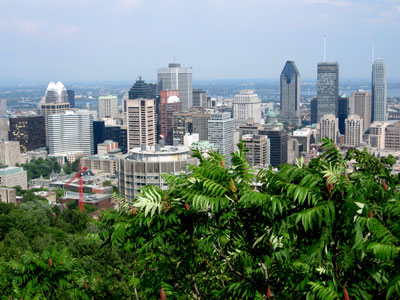
View from the Kondiaronk lookout
Our brief tour of Mont Royal concluded with a tour of the Westmount
residential area, an independent city of about 20,000 residents
fully enclosed by the City of Montreal. Westmount has long been
the traditional residential area of Montreal’s Anglo-Saxon
elite and many Neo-Tudor or Neo-Georgian residences attest to the
wealth of this area. Greene Avenue is one of the commercial streets
in the area and features many of Westmount’s trendiest shops.
Further east along Sherbrooke Street, one of Montreal’s thoroughfares,
is the Golden Square Mile, once the enclave of the Canadian upper
class between about the 1850s and 1930s. Most of the residents were
of Scottish descent and acquired their wealth in the furtrading
business. During that era about 70% of Canada’s wealth was
concentrated among the residents of the Golden Square Mile. Today
only a few of the Victorian houses remain and many of the buildings
house retail stores. Part of the Golden Square Mile is McGill University,
Montreal’s oldest university, founded in 1821 as a result
of a generous donation by Scottish-born fur trader John McGill.
On our way back to my hotel we also passed UQAM, the Université
de Quebec à Montreal, the city’s youngest university,
founded in 1979 and a thoroughly modern addition to the city.
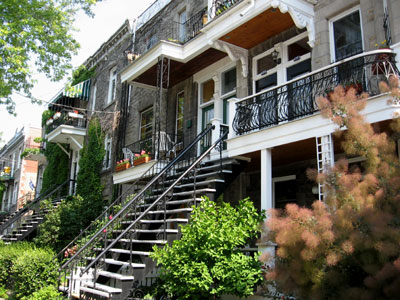
Typical homes in Montreal's Plateau neighbourhood
No doubt this was a whirlwind tour, but at the same time these
3 hours were a great introduction to this fascinating city. Something
I would be able to mull over during my dinner
at Modavie, accompanied by a little jazz….
Useful books about travel to Montreal:
Related articles:
Hello from Montreal 2006 - My 4-day
explorations of Montreal
Hello from Montreal: An interesting
train ride and first impressions
Hello from Montreal: Getting
the lay of the land in a driving tour
Hello from Montreal: Dinner and a
little jazz at Modavie
Hello from Montreal: Reliving
history with the Old Montreal Ghost Tour
Hello from Montreal: Architectural
discoveries in the Old Montreal Walking Tour
Hello from Montreal: Exploring
the Chateau Ramezay during a torrential downpour
Hello from Montreal:
Mexican delights at La Iguana & a peak at the Jazz Festival
Hello from Montreal: A guided bicycle
tour to explore Montreal's neighbourhoods
Hello from Montreal:
Biking on the Lachine Canal - Industrial history turned into a recreational
opportunity
Hello from Montreal: A chat with
André Giroux about Bicycling in Montreal
Hello from Montreal: Savouring Italian
cuisine at Galiano's and Canada Day Celebrations
Hello from Montreal:
Exploring the Olympic Stadium, the Botanical Garden & Insectarium
and outdoor action at the Jean Talon Market
Hello from Montreal: A Peruvian immigrant
success story at Restaurant Mañana
Hello from Montreal: Friendly
neighbourhood encounters on Square St. Louis
Hello from Montreal: Exploring
the Casino de Montreal
Hello from Montreal: Gourmet
dining at Nuances and amazing fireworks at La Ronde
Hello from Montreal: A final walk
to discover amazing architectural beauties
Helpful links for travel to Montreal:
Tourisme
Montreal - Montreal's official tourism information office
Quebec Tourism
- Official tourism website for Quebec
|